Who’s got two thumbs and shipped her first of 12 startups in 12 months on schedule? That’s right, this girl.
In its first week, the Blogging for Devs Community reached $5K in revenue through a combination of lifetime deals, subscriptions, and my first ever Bitcoin transaction (thanks, Nico!).
A profitable first week isn’t what makes this a success in my book.
I’m thrilled at all the cool members who decided to join. Exactly as I’d hoped, each person adds something unique and interesting to the community, and I’m really excited to see where it goes.
So, welcome to my first monthly retrospective.
In this post I’ll be sharing a behind-the-scenes look at the first week of my paid community launch and reveal what I’m shipping in November.
Below you’ll discover charts, graphs, screenshots, strategy, reflections, and my master plan for growing Blogging for Devs through viral, generated content 🔮
I promise, it’s good.
How I launched a paid community in one month
First question: Did I really?
Before talking about what I’ve been up to in October, it’s important to get on the same page about this:
Even though I began charging to join the community this month, the community itself was launched as a sort of “closed beta” back in July.
The newsletter that helped me connect with first 100 free members (and most of the paid members — more on that later) was launched in May.
You know what they say about overnight success.
Anyway, here’s what and how I launched in a month.
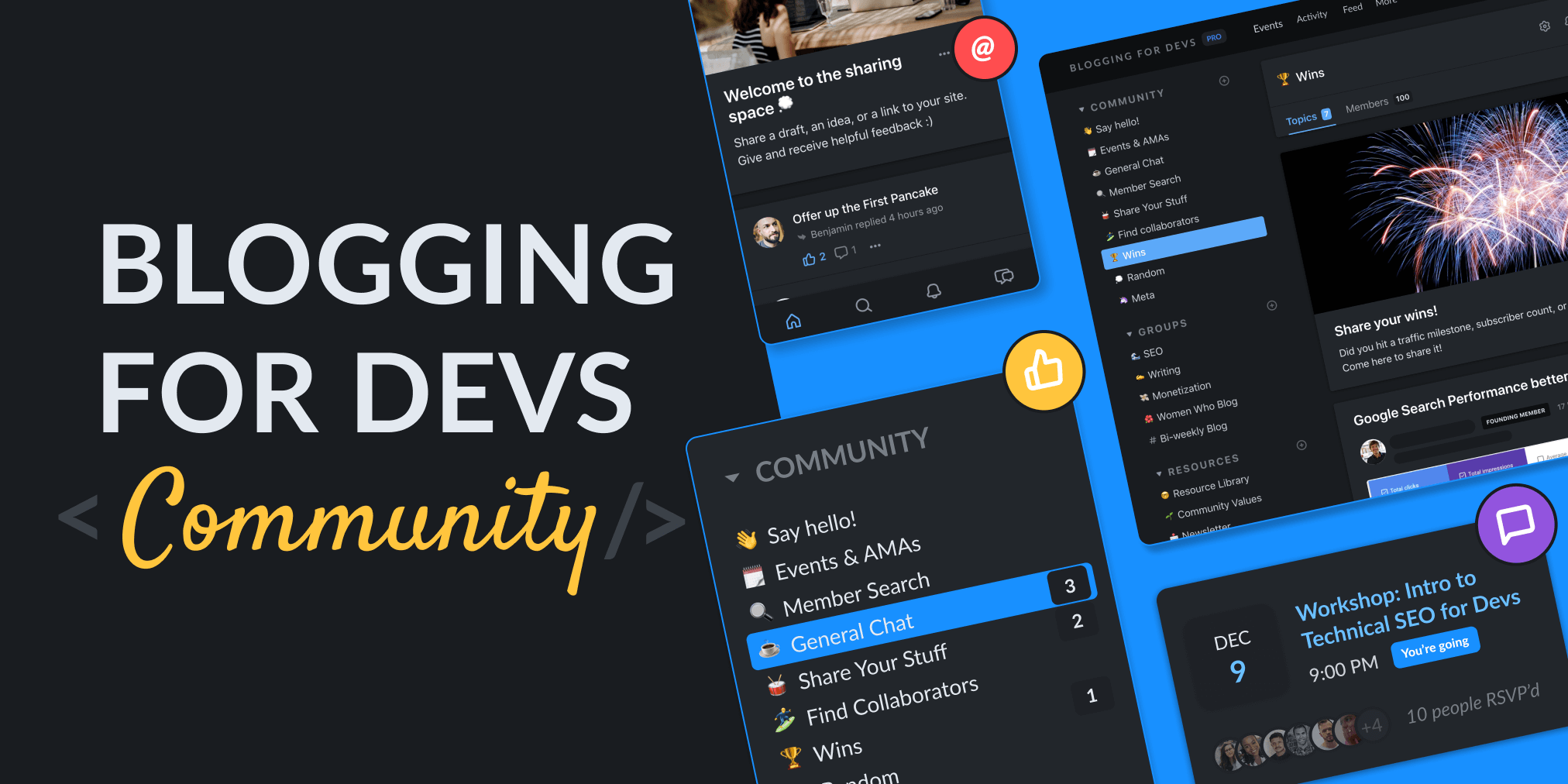
Blogging for Devs Community is a paid community for developers, makers, engineering managers, and technical founders to grow their blogs through feedback, collaboration, and continuous learning.
We have accountability groups, virtual events and workshops, members-only resources and original content, and most importantly — super kind and knowledgeable members.
For the first 250 people to join, it costs $12/month, $96/year, or $180 once.
The discussions are powered by Circle and rocking a custom theme I hacked together through highly specific CSS selectors and vanilla JavaScript.

And they say you only need to know React these days 😝
It integrates with the Gatsby website through a custom OAuth provider, which uses Firebase for authentication. It’s all serverless and cloud native and such.
In October, I built Events, a member RSS feed, signup, payment, the landing page, onboarding, profiles, welcome email sequence, and a lean batch of starter content. I designed everything myself in Figma. For more granular detail on building the product, you can see the day-to-day in my twitter thread.
Enough about tech, let’s talk launch.
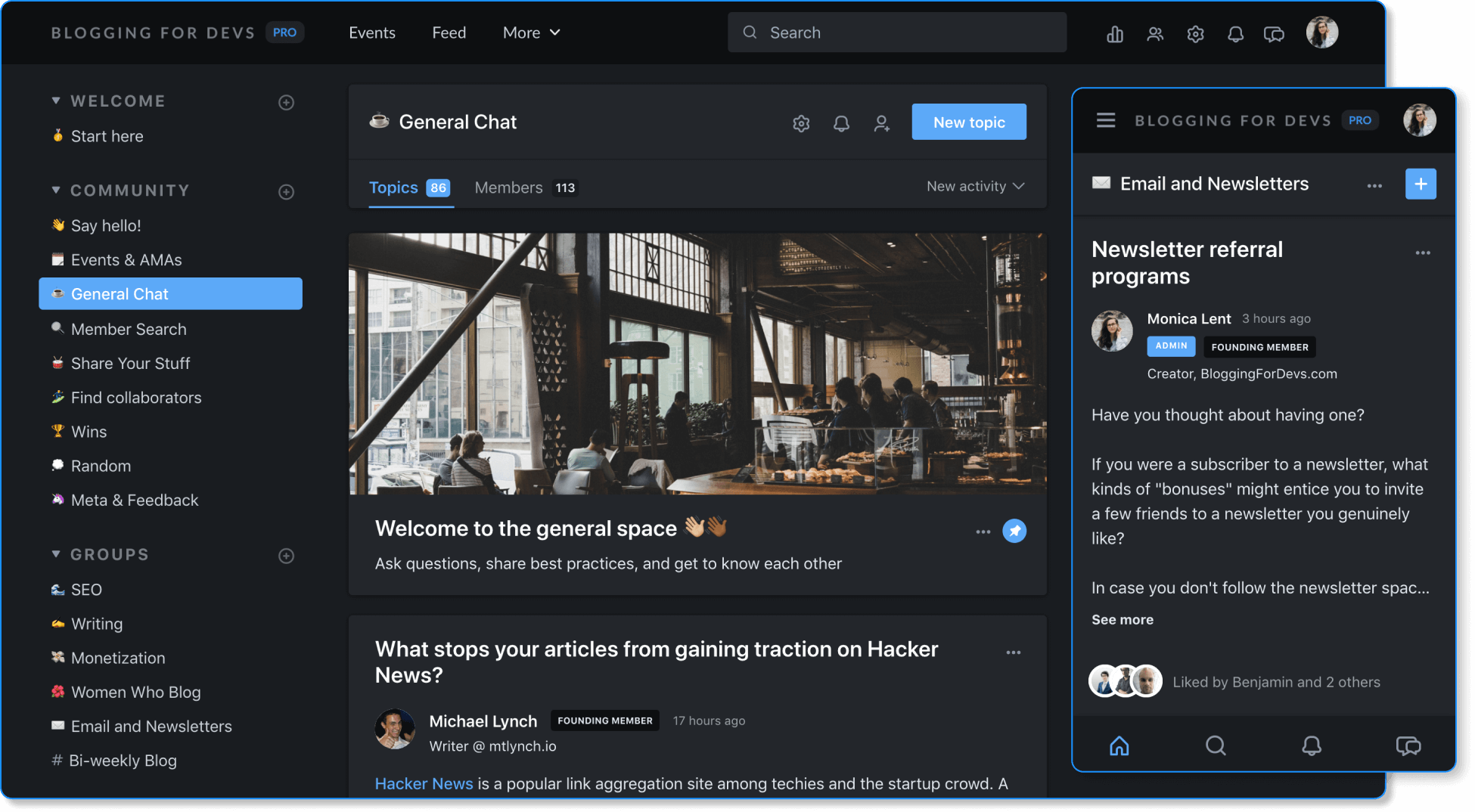
Success metrics: Why you won’t find an overall conversion rate in this report
My real goal for the community was to get great people in, and not to overly optimize for converting anyone with a pulse.
That’s why my biggest launch fear wasn’t that no one would sign up.
It was that people I don’t like would sign up. Spammers, self-promoters, attention-seekers, jerks. Thankfully it hasn’t been the case and everyone is awesome so far 🤞
I try to scare those types away with a prominent Code of Conduct and an “Is this right for you?” checklist.
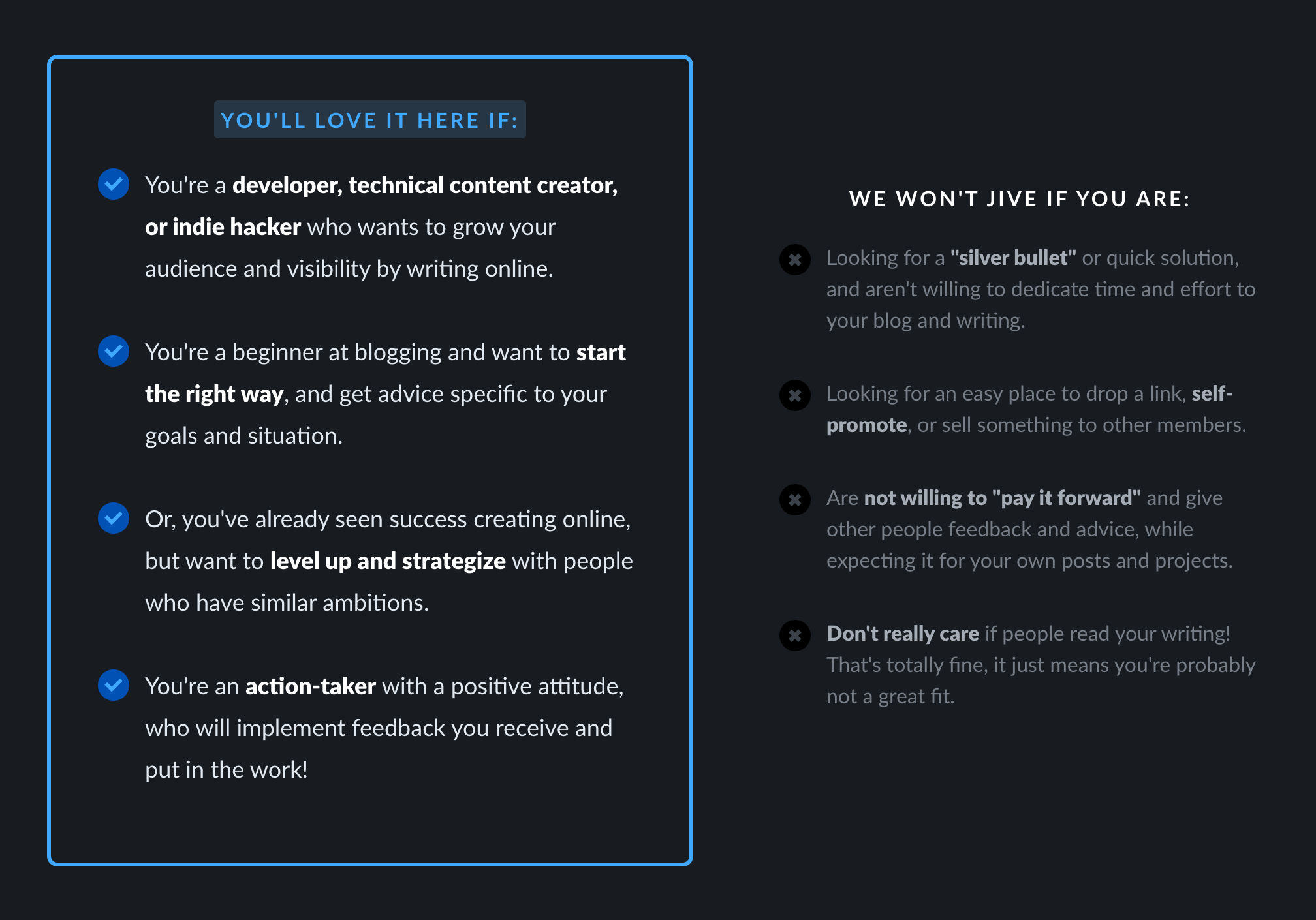
That’s why I have no idea what my “conversion rate” for the community is and I don’t actually care.
I do pay attention to the opt-in rate for my free newsletter, though, so don’t take this as, “Girl doesn’t care about metrics.”
I care about metrics, just not on the community landing page.
The reason is, joining a community is a long-term thing. Something like this often takes time and multiple exposures for people to make the decision — it was the same for me and Rosieland and Trends.
The more interesting question is this:
What I can I learn about the members who did sign up, so I can find more people like them?
With that, it’s chart time 👯♀️
So, where did the paid community members come from?
Were paying members wooed by my slick landing page, or convinced by a carefully crafted tweet?
Turns out, probably not.
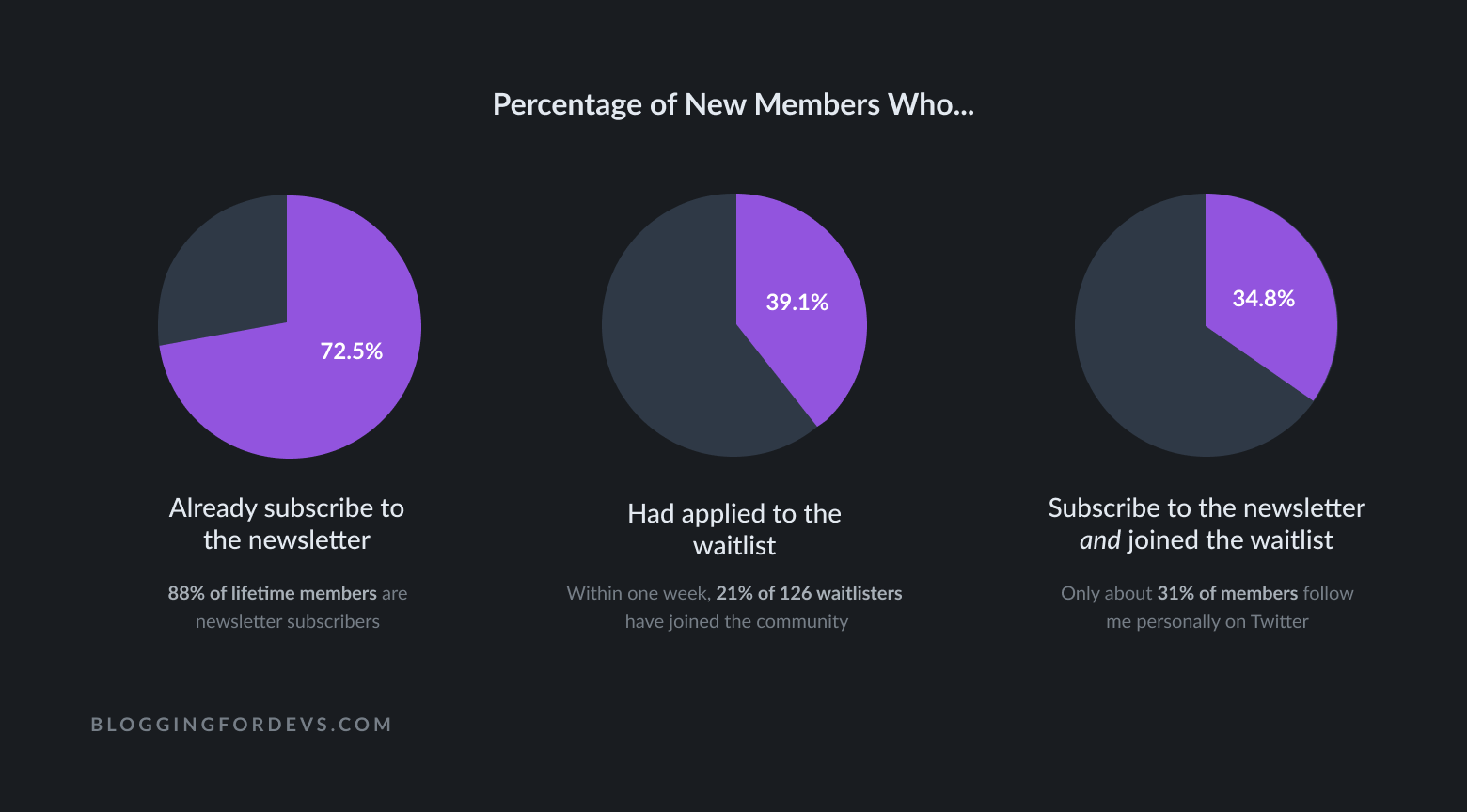
Most new members were already subscribed to my free weekly newsletter about blogging for developers, which is about 4,000 subscribers strong.
Every Friday for nearly six months, I’ve been sending out original content about blogging, SEO, going viral, attracting an audience, and a splash of motivational moments. It takes me an entire day to write.
Out of 69 new paying members in the first week, only three were unattributable at least one of three sources:
- Waitlister
- Newsletter Subscriber
- Twitter Follower
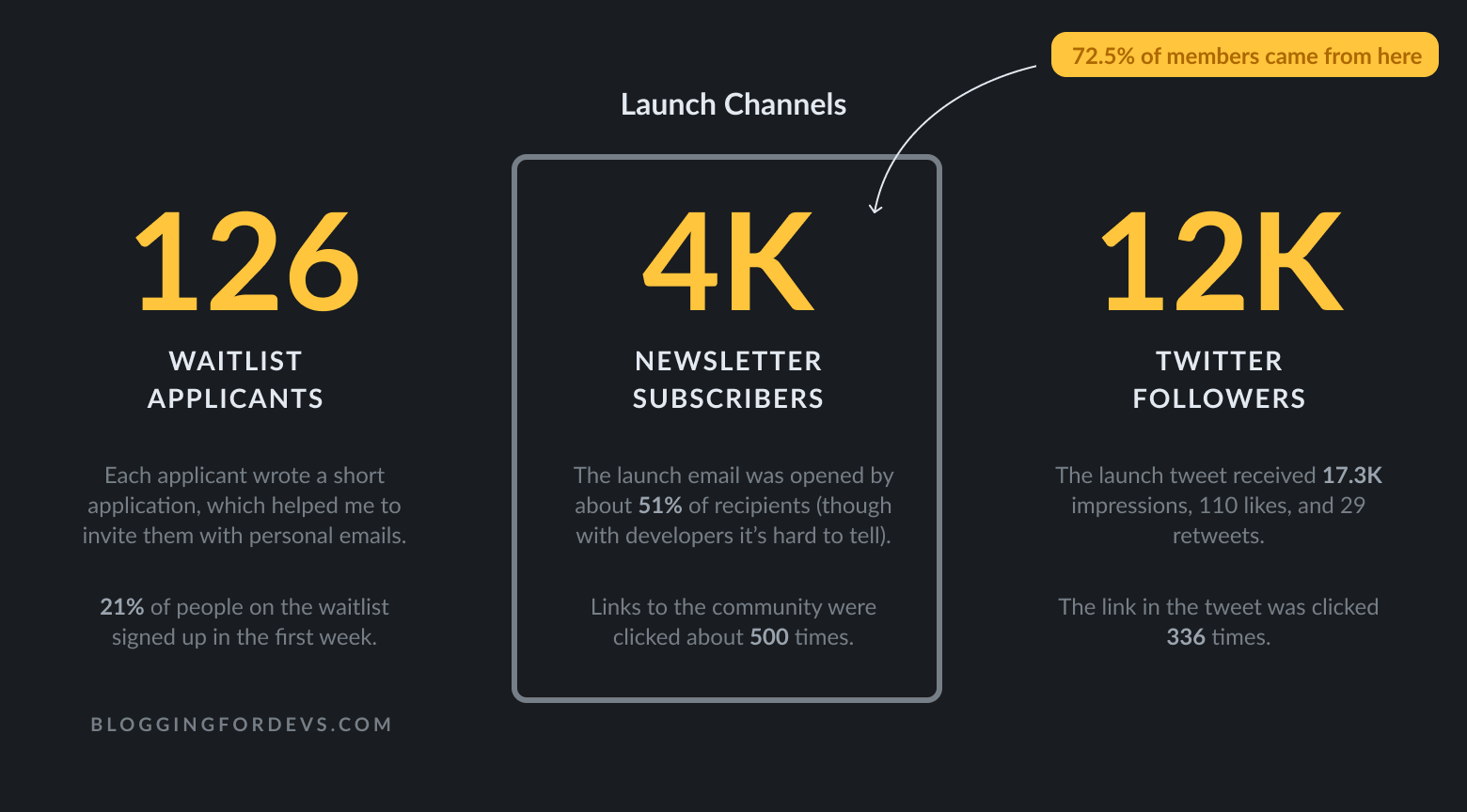
Newsletter backstory: I started the newsletter in May, and it’s since grown to over 4,000 subscribers. If you want to know how, check out the writeups I’ve done here and here.
Many people had multiple touchpoints: subscriber and on the waitlist, or followed me on twitter and subscriber to the newsletter.
However, only 31% of new members follow me on Twitter. I’m not offended, to the contrary — I prefer it.
Now I know that if I want to grow the community, the best thing I can do is have more of the right people join the newsletter first.
That’s why my goal is to grow the newsletter, and trust that the community will eventually benefit from the best subscribers joining up.
Let’s take a dip into revenue for a second.
How much and where did revenue come from?
As I said in the tweet where I collected ideas for this article, the $5K revenue is not MRR (monthly recurring revenue).
MRR for the Blogging for Devs Community is just $516 according to Stripe.
So where did the first week’s $5K in revenue come from?
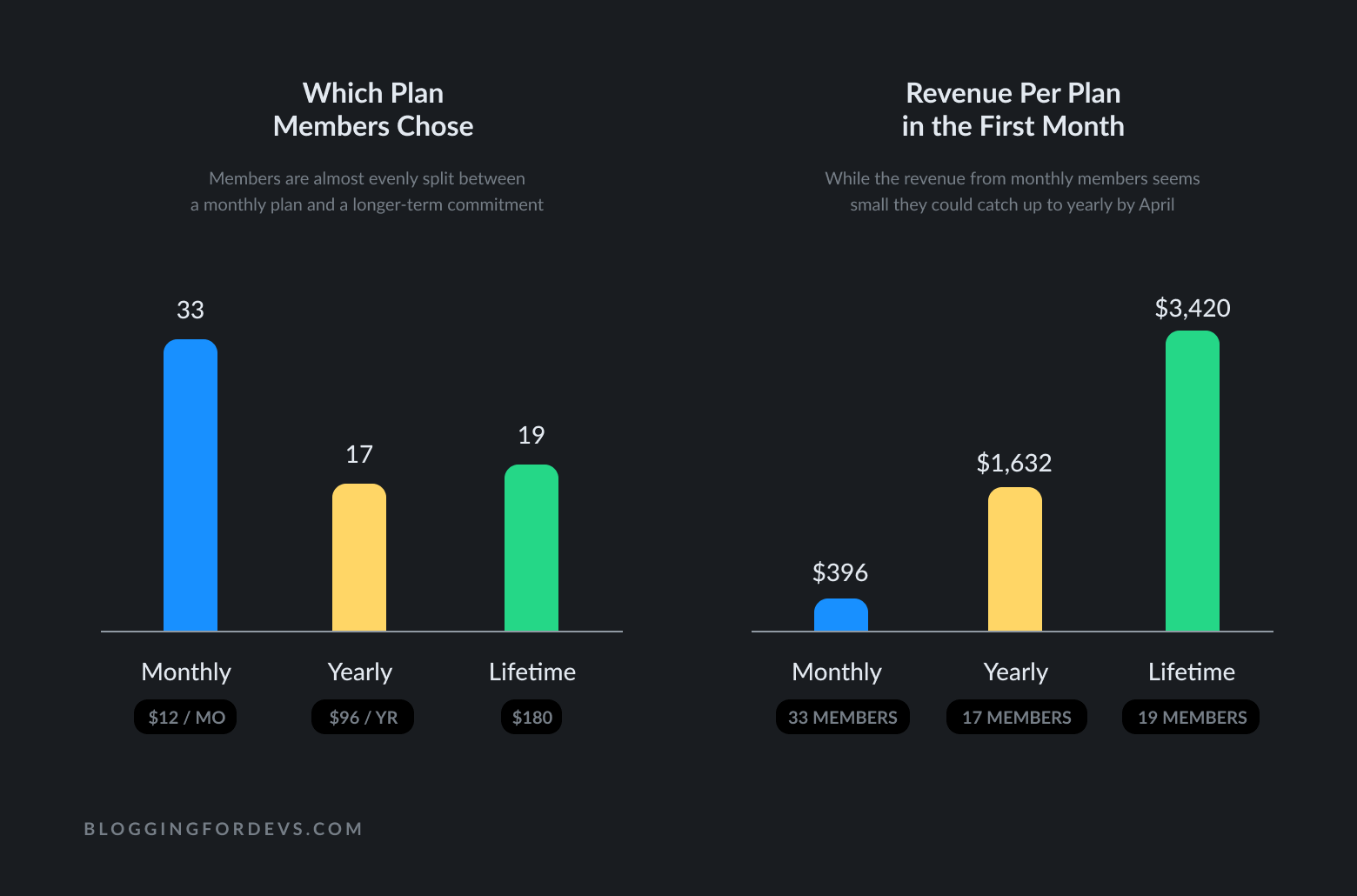
Someone on Twitter recently asked me if I have any “thought leadership” to spare on the topic of lifetime pricing.
I don’t.
Guess what, I’m neither optimizing for conversion nor LTV 🙃
Offering a lifetime price at a lower cost than 2 years as a member is really just a way for me to say “Thank you” to people who are in it for the long haul.
I see it as a mutual commitment.
Is this sustainable yet?
You might see $5K in a week and think it sounds like a lot of money. If only one could extrapolate that to $20k/mo, then I’d be set.
But of course, it’s not the whole picture:
- Taxes and healthcare are super expensive here in Germany
- I already spend over $300/mo on SaaS tools to run the community
- Only $500 currently recurs monthly, assuming zero growth/churn
Still, I have a very long way to go before the community is sustainable.
That’s why my November startup is a side project to scale reach of the newsletter, which should in turn drive the growth of the community.
I think marketers would call this a “funnel”.
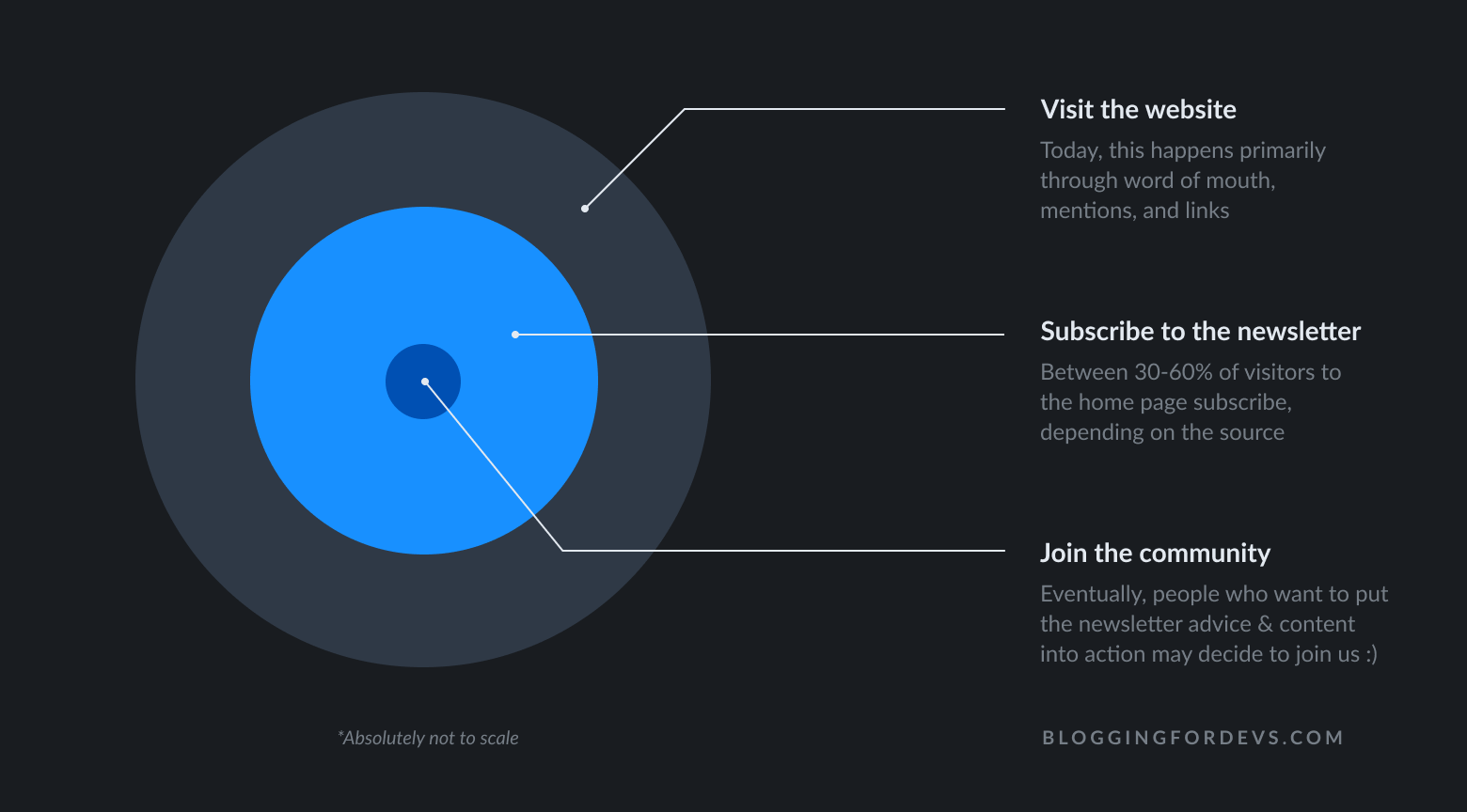
I think about it a little more like concentric circles approaching a core.
My next task is to expand the outermost ring with the kind of people who are likely to join and enjoy the newsletter.
My master plan for growing Blogging for Devs beyond Twitter and word of mouth
Channels die. Or at least, they become exhausted.
Although people still write me emails saying they’ve been following for years, and just found out I have a newsletter — most of that is probably in the past.
People who know me, know about Blogging for Devs.
I really don’t want to spend all day on Twitter “growing my social media presence”. I’d rather be building cool shit and helping other people build cool shit, too. Let people find me through that.
Right now, word of mouth is what grows the newsletter.
Random mentions and links. I find out through welcome emails or through stalking my backlink reports from time to time.
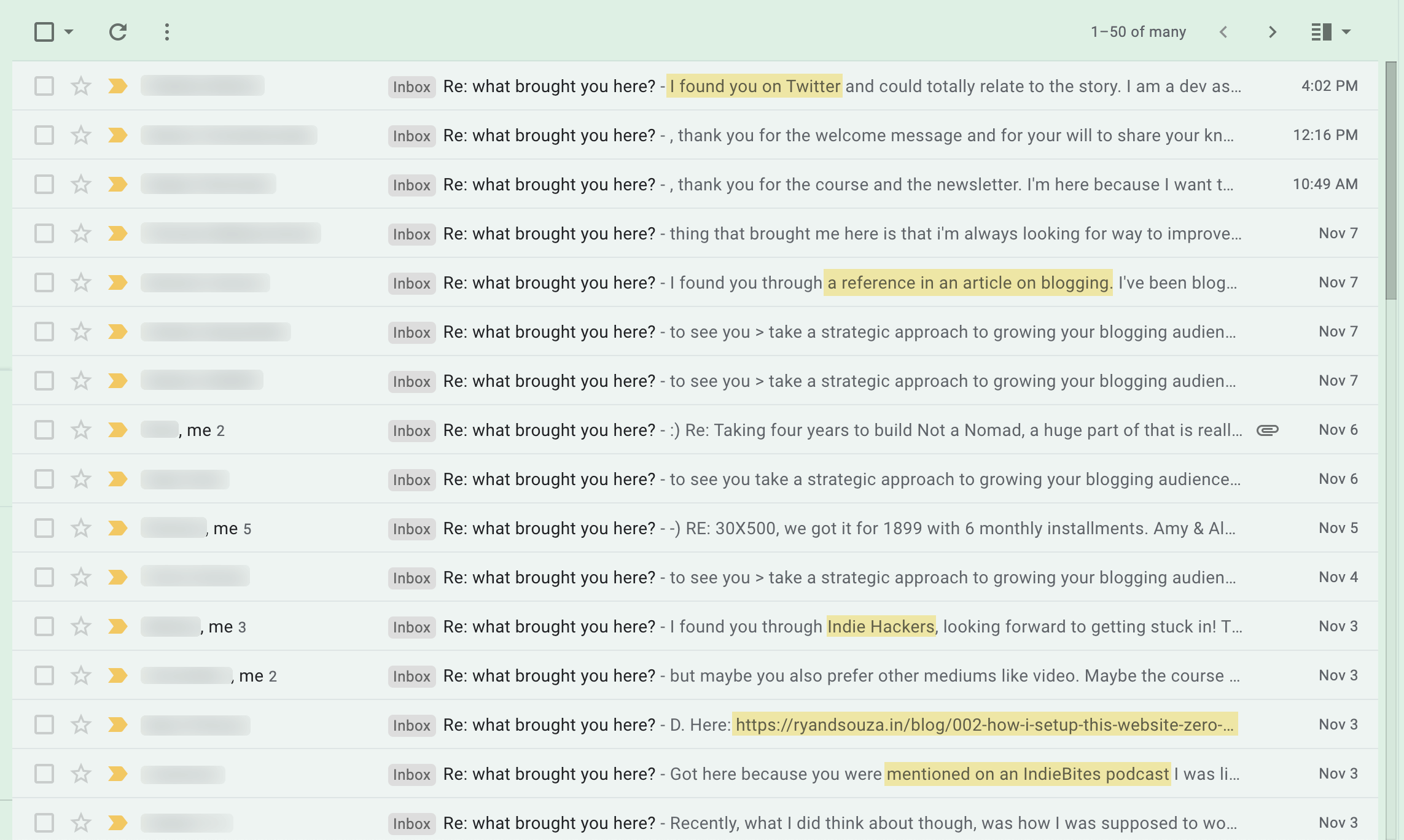
I do reply to everyone who emails me, but I was running a bit behind after spending the prior week following the US election 🙈
On average, I gain about 5-10 subscribers per day.
A prominent mention on Twitter, Indie Hackers, or the success of a subscriber’s blog post can push than number over 100.
The problem? Today, word of mouth isn’t sufficient to grow the newsletter quickly enough to reach sustainability in the near term.
Ironically, I’m also a blogger with no spare time to grow it writing a ton of individual blog posts 😅
So how can I grow my newsletter about blogging, without blogging myself, and without relying on Twitter for all my traffic?
Here comes the master plan. I hope it works.
How I’ll build traffic to Blogging for Devs (while writing virtually no blog posts)
I have a theory. Well, I have a few theories.
The first one is this: Developers want to discover blogs written by other developers. Reading company engineering blogs is fine, but quality content from their peers or individuals they admire is far more interesting.
Most places to discover developer content feature individual articles. Hacker News, Reddit, and Twitter all fundamentally work this way.
But what’s more interesting is the person behind the blog. Their personality, what makes them unique, inspiring, and worth following in their own right.
To back this up, I present Exhibit A.
Dear Tech Twitter:
— Monica Lent (@monicalent) August 27, 2020
What is your NUMBER ONE favorite blog by someone in tech, who has a *distinct writing style*? Where you read their articles for their *unique personality or voice*?
(Pls no list of twitter handles, direct link to the blog is 👍)
Apart from the fact that asking for any kind of recommendation on Twitter is a one-way ticket to pandemonium, you can tell from the replies that people feel strongly about the topic. 400+ responses.
When I build something, I like that the topic evokes a response like this.
It means people care.
Extension of the theory (this time with less evidence): Many people who read amazing tech blogs also aspire to create one themselves.
Ergo, if I create a place for people to discover the best developer blogs, there’s a good chance people who show up will like my newsletter, too.
So here’s my plan.
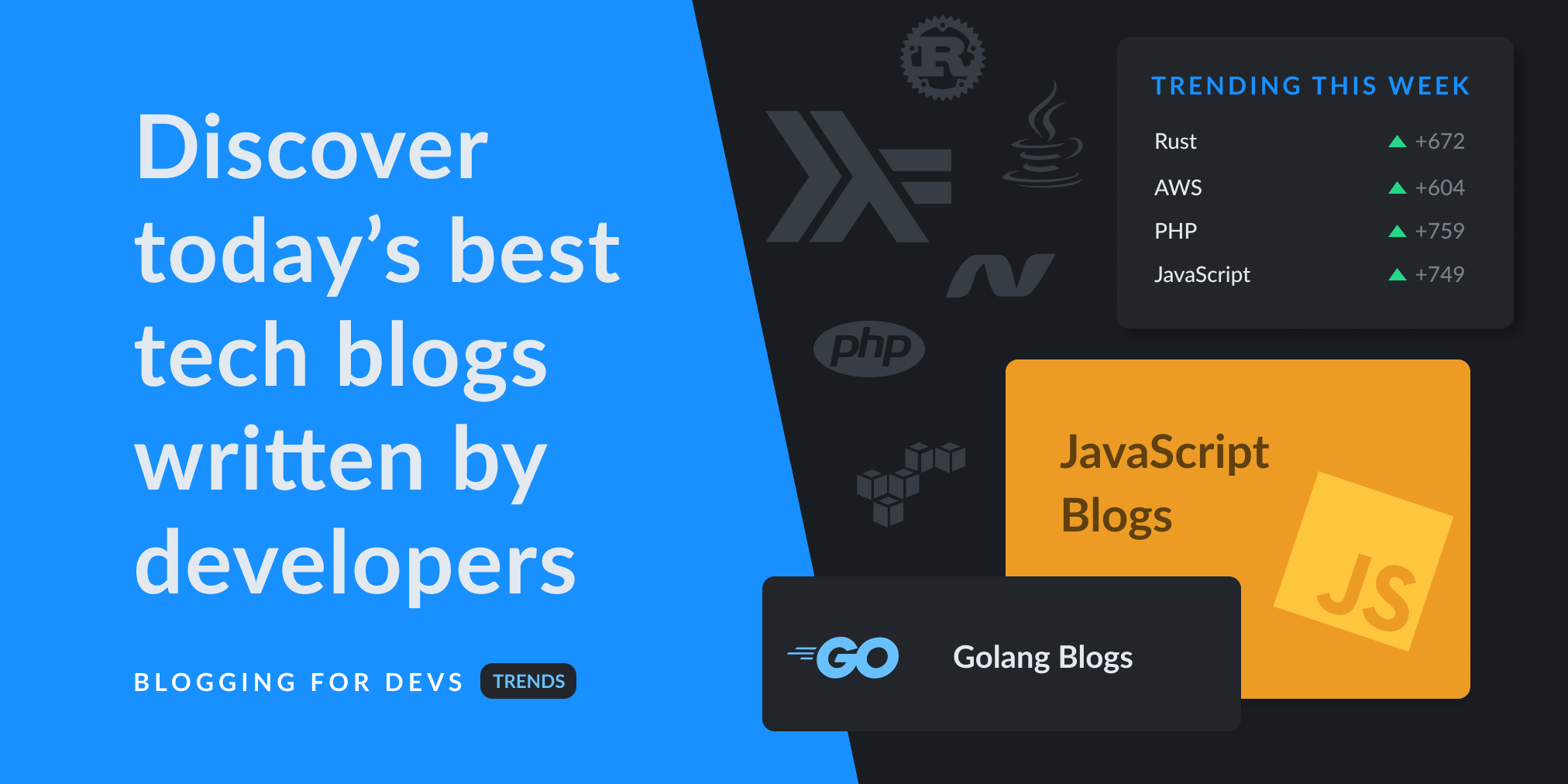
What I’m launching in November
My plan is to crowdsource recommendations for the best tech blogs across a number of tech stacks, written by individual developers.
With this seed data, I’ll generate “Top 50” lists of the best technical blogs across a variety of topics, designed to help people discover amazing authors and attract people to the newsletter.
Which blogs are best will be curated by me for quality, then ranked by engagement on Twitter, favoring unique mentions and word-of-mouth recommendations by other developers.
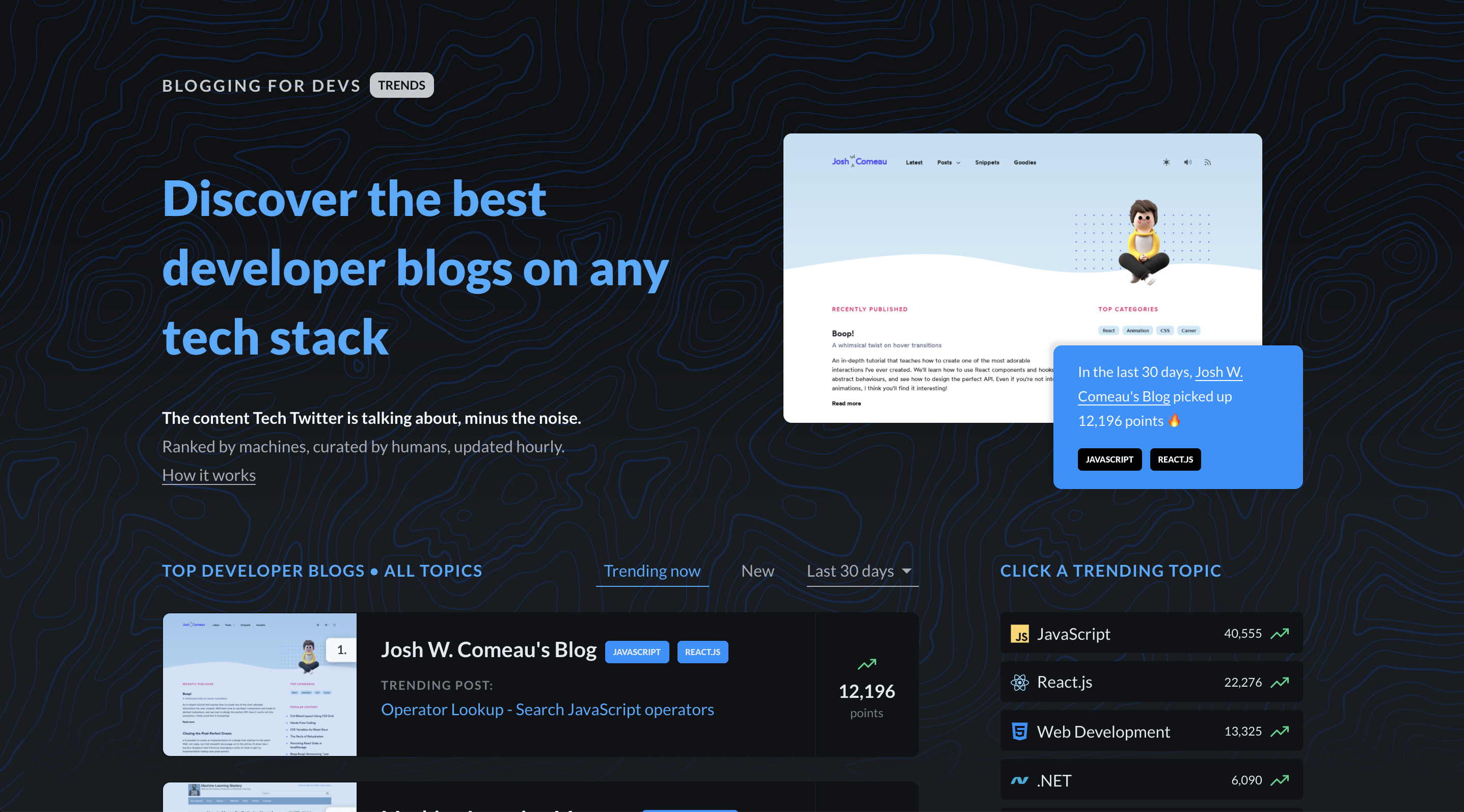
In turn, these each of my lists will rank for relevant keywords in Google, driving search traffic to the website every month.
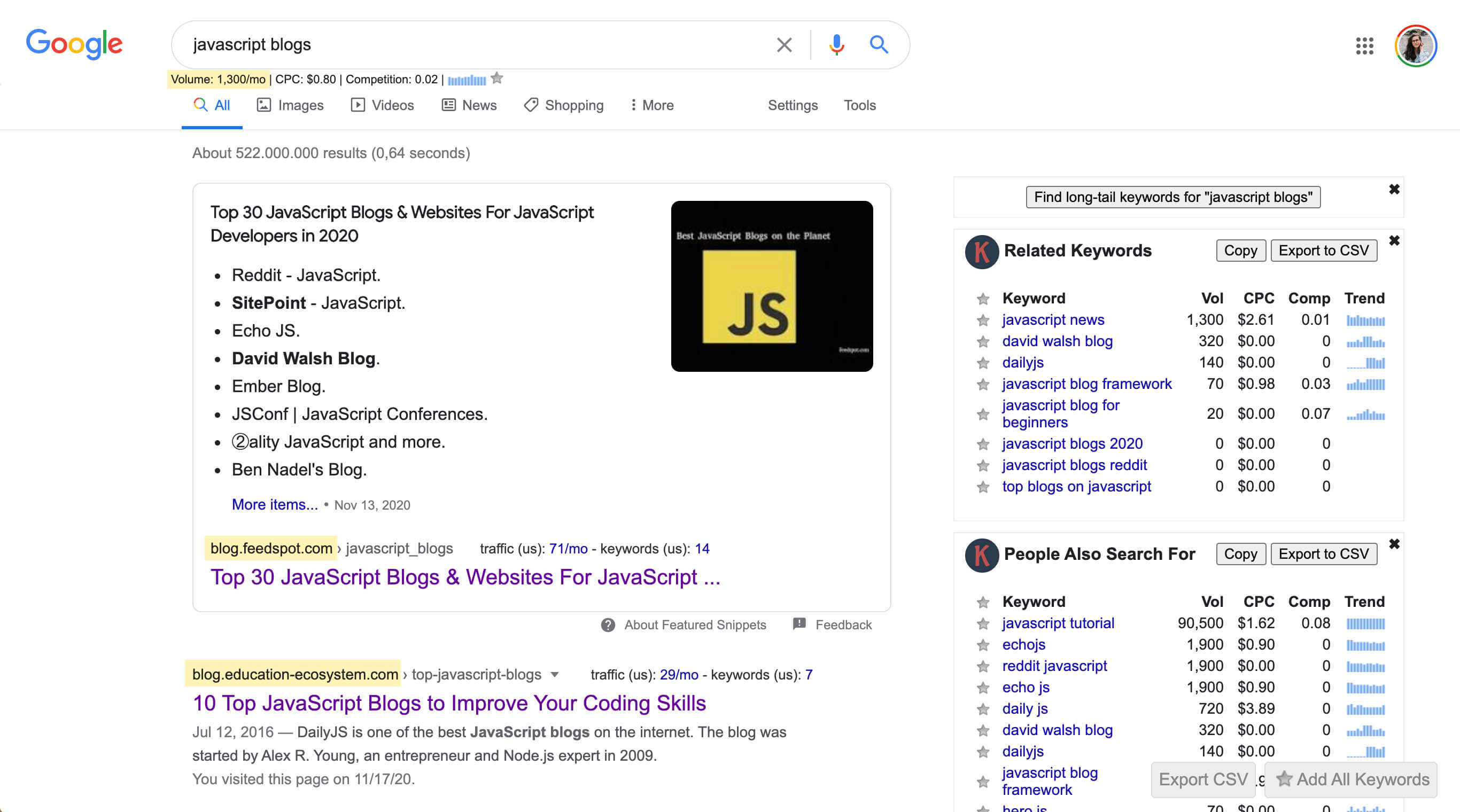
For example, my page about the best “JavaScript blogs” will hopefully show up first for that search term, and provide genuinely great recommendations of individual developers who write about JavaScript.

As my final trick, I’ll try to make it go viral.
I’m going to launch it on Hacker News at the end of the month, and will continue to tailor the features, design, and copy around that audience.
I plan to add things I hope developers there will see and think, “That’s cool.”
For example: realtime data updates, data visualizations, tasteful SVG animations, and the ability to filter and sort the data.
If I succeed, the avalanche of backlinks it receives by being on the front page of Hacker News will help it rank higher and faster in Google.
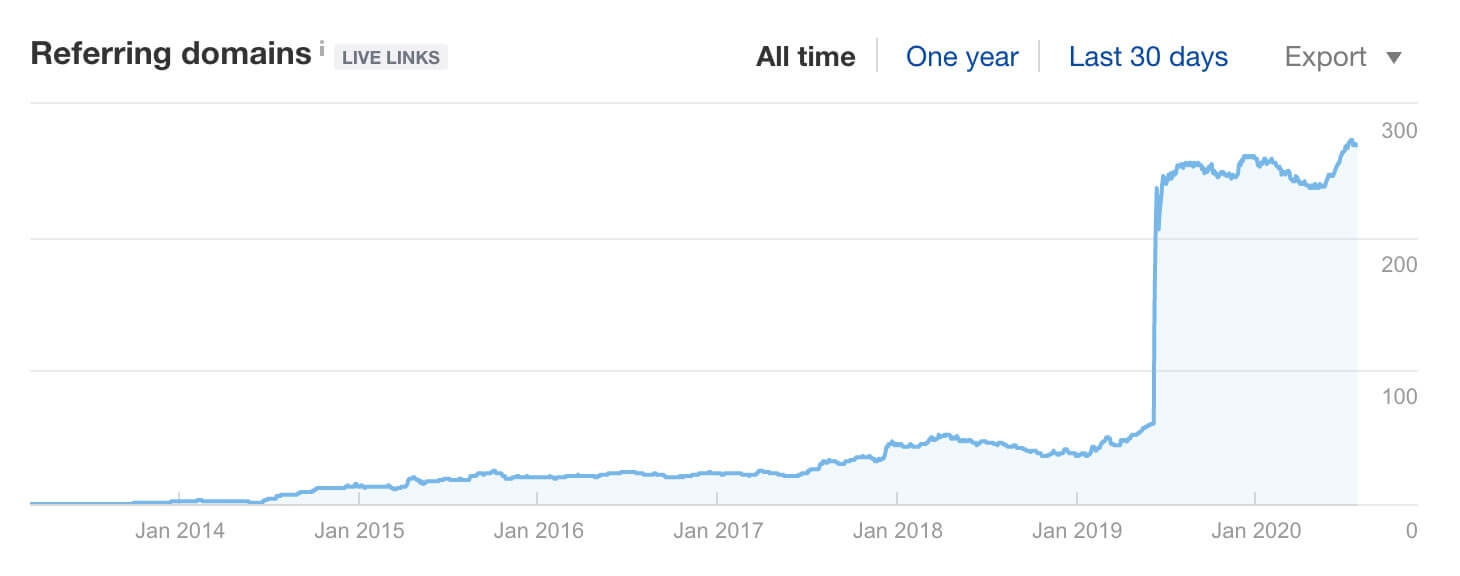
What happens when you hit the front page of Hacker News
If I can’t make Hacker News love it (or at least, upvote it), I’ll probably still rank. It might take a few months, though.
And since the content is generated, I can easily scale out into the longtail for more niche technologies.
If it sounds smart, it is. I also didn’t come up with it. I was originally inspired by Detailed.com’s blog rankings but there are a lot of places out there doing generated content for SEO.
It’s just, most of them have terrible recommendations and look ugly (looking at you Feedspot). That’s why I’m hoping I can outrank all of them, provided I can get sufficient links.
In case you’re wondering, “How’s this going to make any money?”
It’s not. The goals are backlinks and traffic.
Wrapping it up: What I learned launching a paid community (so far)
You made it to the end. Welcome to the bottom of the page!
As a reward, here’s a handy graphic with the main things I learned launching a paid community earlier this month:
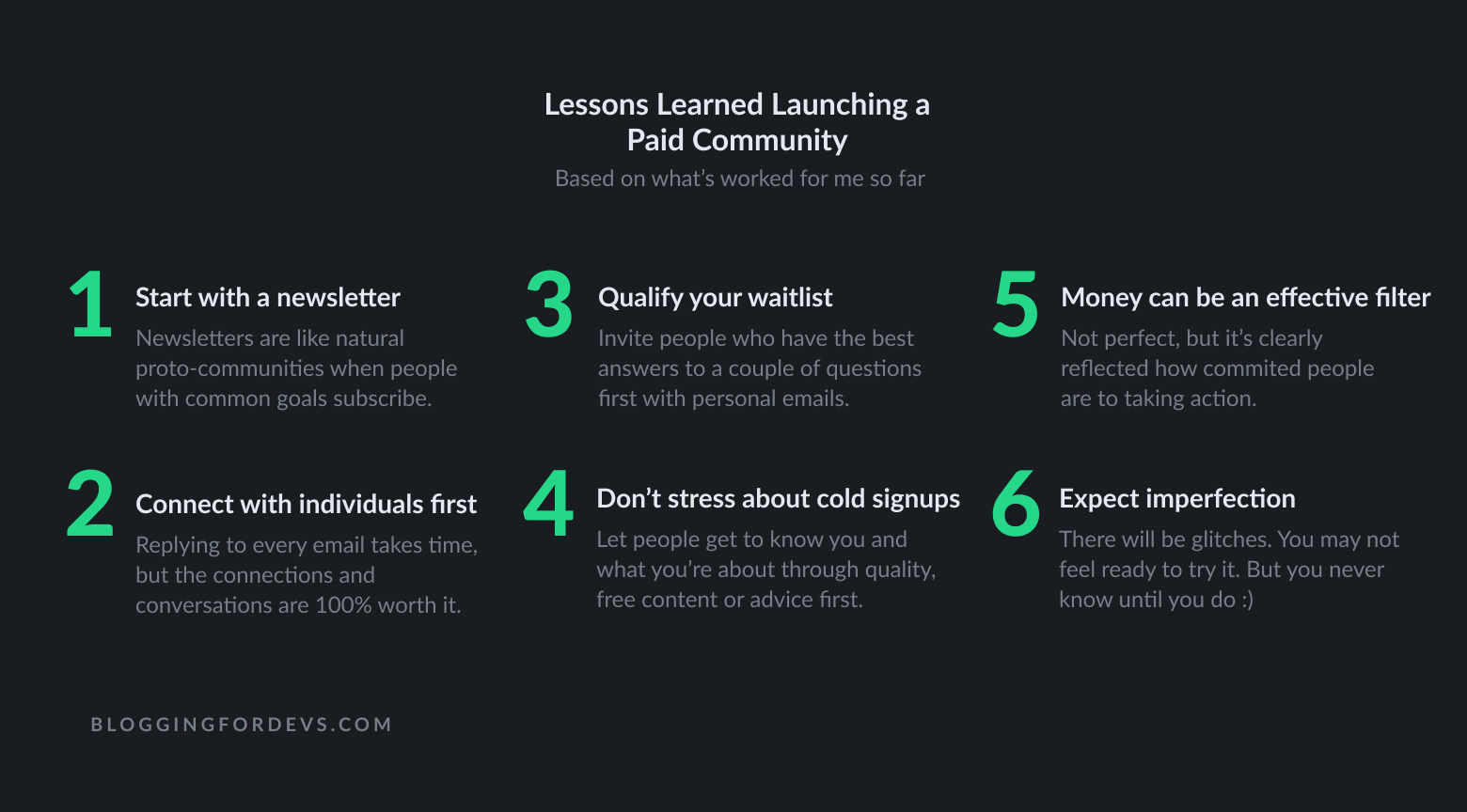
In a nutshell, this would be it:
- Start with a newsletter, they are like proto-communities.
- Connect with individuals first through welcome emails.
- Qualify your waitlist and invite the best fits first.
- Cold signups may not work for an early stage paid community.
- Money can be an effective filter for motivation.
- Imperfection arises when people are involved. Embrace it!
That’s a wrap on my first month of shipping a product every thirty days.
This month, I’m going to be creating a Technical SEO Workshop for the community, trying to reach 100 paid members (+9 from Nov 25th, 3 weeks post-launch), and last but not least – go viral on Hacker News.
Want to watch me try to do all of this in the remaining week of November? Or fail in a wildly public fashion?
You can follow as it unfolds live on Twitter @monicalent 😁
What did you think of the community launch and my ideas for this month?
Let me know by replying on Twitter (and wishing me luck!)
I've been laboring over this blog post all month, so now it's finally in the wild 🐻🌲
— Monica Lent (@monicalent) November 25, 2020
It's a breakdown (with charts!) of the @bloggingfordevs community launch + my plans to grow from here.
I'm also launching something new soon, preview inside :)https://t.co/n6M3OPpold







